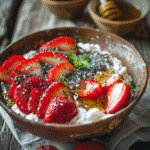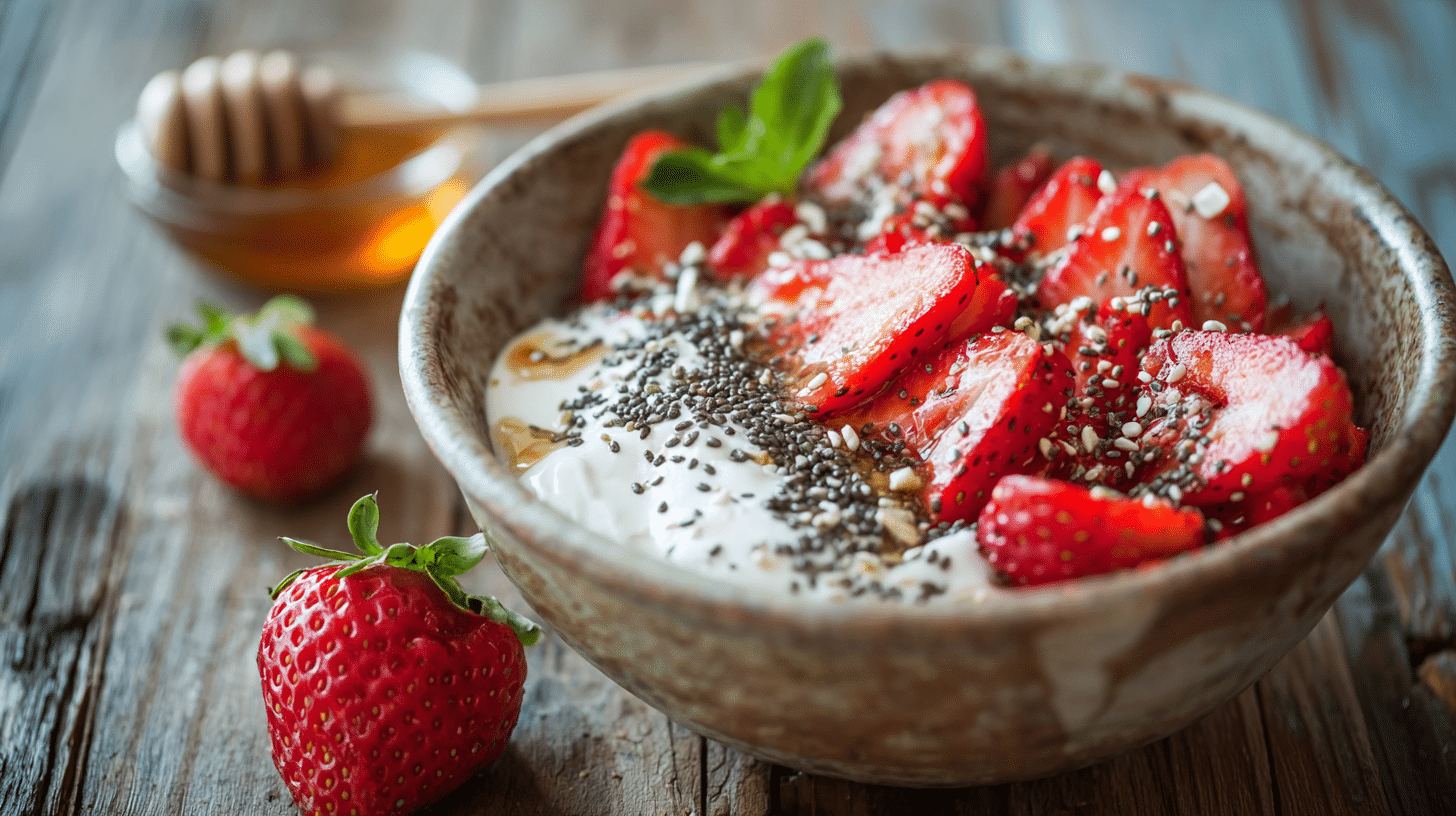
Looking for a high-protein meal that’s creamy, savory, and takes five minutes to throw together? A cottage cheese protein bowl might just become your next kitchen go-to. Whether you’re meal-prepping for the week or pulling something together post-workout, this humble bowl hits all the right notes—easy, customizable, and packed with nutrition. In this post, I’ll walk you through exactly how I make mine, why cottage cheese is the underrated star of high-protein meals, and how to build flavor into every bite.
A Cottage Cheese Protein Bowl That Started in My Fridge
Why I Started Making Cottage Cheese Bowls
Cottage cheese wasn’t always a fridge staple for me. Back in culinary school, we used it mainly in desserts or to fill pastries. But once I became a mom and needed protein-packed meals that weren’t eggs or chicken every single day, cottage cheese came back into the picture. I started with a basic cottage cheese protein bowl—just the cheese, some veggies, and a drizzle of olive oil. It hit all the right marks: fast, flavorful, and so satisfying. These bowls have since become a go-to in our house, especially on chaotic mornings or when we need a no-fuss dinner.
You can prep most of the mix-ins ahead of time (like roasted veggies or cooked quinoa), then just scoop, top, and serve. Even my kids—both of whom side-eye anything that looks remotely “healthy”—enjoy it when I throw in a little shredded cheese or crushed tortilla chips for crunch. It’s one of the rare meals that works for everyone. I’ve even paired it with these cottage cheese egg bites or gluten-free cottage cheese pancakes for a full-on protein breakfast spread.
What Makes It a Protein Powerhouse
Each cottage cheese protein bowl delivers a whopping 20–25 grams of protein per serving, depending on your mix-ins. What’s cool about cottage cheese is that it gives you both casein and whey protein—the slow and fast-digesting types—which means longer satiety and steady energy. If you’re trying to hit protein goals without relying only on meat, this bowl is a smart option. It’s also lower in fat compared to something like sour cream, and you still get that creamy texture.
You can also build your bowl in endless ways: Mediterranean with cucumbers and hummus, taco-style with salsa and beans, or sweet with berries and a drizzle of honey. It’s more versatile than you might think. Want an easy way to meal prep it? Try making cottage cheese overnight oats for a grab-and-go version.
How to Build the Perfect Cottage Cheese Protein Bowl
Benefits That Go Beyond Protein
A cottage cheese protein bowl isn’t just another trendy health food—it’s a smart, balanced meal that fits into nearly every dietary approach. It’s low in sugar, rich in calcium and B12, and packed with complete protein. Whether you’re following a gluten-free, high-protein, or low-carb lifestyle, this bowl delivers on both nutrition and flavor.
In our kitchen, cottage cheese protein bowls are regulars for a reason. They’re fast, filling, and endlessly customizable. Cottage cheese provides about 14g of protein per ½ cup, and when you top it with fiber-rich vegetables, nuts, or grains, it becomes a complete, nourishing dish. I often add leftovers from our favorite family-friendly gluten-free meals to bulk it up.
Another perk? Cottage cheese contains casein—a slow-digesting protein that keeps you feeling satisfied for hours. When my kids need a solid after-school snack, I build them mini cottage cheese protein bowls with fruit, honey, and seeds. It’s a delicious way to fuel up without the crash that comes with sugary snacks.
Customizing Your Cottage Cheese Protein Bowl
Every time I make a cottage cheese protein bowl, it’s different—and that’s what makes it fun. Start with a generous scoop of cottage cheese, then add your favorite toppings. Want savory? Add roasted veggies, quinoa, and olive oil. Craving sweet? Try berries, cinnamon, and almond butter. You’re only limited by your imagination.
Here are some go-to combinations we love:
Savory Options:
- Cherry tomatoes + cucumber + olive oil + smoked paprika
- Avocado + roasted chickpeas + scallions + lemon juice
- Sautéed spinach + garlic + hemp seeds + balsamic glaze



Sweet Ideas:
- Strawberries + chia seeds + honey
- Banana + nut butter + granola crumbles
- Mango + coconut + a pinch of sea salt



I love pairing a savory cottage cheese protein bowl with something like these sheet pan spinach egg white wraps, or keeping the vibe sweet and hearty with leftovers from our vegetarian gluten-free recipes.
Meal prepping? These bowls stay fresh for 2–3 days in the fridge when stored separately. Make three at once, rotate the toppings, and you’ve got breakfast or lunch ready without any fuss. I often double batch ingredients and use them in both bowls and one-pan gluten-free meals for extra efficiency.
Making Cottage Cheese Protein Bowls Part of Your Weekly Routine
Easy Serving Ideas for Any Time of Day
One of the best things about a cottage cheese protein bowl is how seamlessly it fits into any meal. It’s great for breakfast with fruit and seeds, works as a light lunch when paired with roasted veggies, or makes a post-workout snack that actually keeps you full. I’ve even served it as a lazy dinner alongside toasted sourdough and a big salad.
For a family-friendly brunch spread, you can prep a few bowl variations and let everyone build their own. That’s something we’ve started doing on weekends, especially when I also have cottage cheese overnight oats or a tray of gluten-free cottage cheese pancakes to go alongside. It turns into a delicious DIY breakfast bar with hardly any effort.
When I’m short on time, I pair a quick savory bowl with whatever I have on hand—leftover veggies, crushed tortilla chips, or even a scoop of salsa. If we’re headed to the park or have a busy day ahead, I’ll pack bowls in jars and throw in a spoon. Easy, nourishing, done.
Prep Tips to Keep It Simple
Here’s how I make cottage cheese protein bowls even easier throughout the week:
- Batch your toppings. Roast a tray of mixed veggies, cook a batch of quinoa, or wash and chop your fruits in advance.
- Use small containers. Keep seeds, nuts, and granola in tiny jars to sprinkle on just before serving.
- Double up. If you’re already making one-pan gluten-free meals or prepping master granola bars, save a portion to use in your next bowl.
You can even take inspiration from other meals you love. Leftover gluten-free corn fritters? Chop them up and use them as a savory topping. Want to go sweet? Toss in sliced strawberries and cinnamon from breakfast prep.

And if you want more inspiration or real-time ideas, I often share quick bowl combos over on Pinterest, X (Twitter), and even behind-the-scenes tips on Medium and Tumblr.
FAQs
Is cottage cheese good for a protein diet?
Yes, cottage cheese is an excellent choice for a protein-based diet. A single cottage cheese protein bowl can deliver 20–30 grams of protein depending on your serving size and mix-ins. It contains both slow-digesting casein and fast-digesting whey proteins, making it ideal for sustained energy and muscle repair. Plus, it’s low in carbs and fits well into most nutrition plans like low-carb, keto, or high-protein diets.
Are cottage cheese bowls good for you?
Definitely. A cottage cheese protein bowl is rich in protein, calcium, and essential nutrients without being high in calories or sugar. When you add in whole ingredients like fruits, veggies, seeds, or grains, you’re building a well-rounded meal full of healthy fats, fiber, and flavor. It’s a smart option for breakfast, lunch, or post-workout fuel that helps you stay full and energized.
What to add to a cottage cheese bowl?
There are endless ways to build a cottage cheese protein bowl. For a savory version, try toppings like tomatoes, avocado, roasted chickpeas, spinach, or olive oil. For sweet options, go with strawberries, bananas, almond butter, and granola. Just combine creamy, crunchy, salty, and fresh elements. If you’re stuck, start with three toppings you love and layer them for taste and texture.
How much protein is in a bowl of cottage cheese?
A typical cottage cheese protein bowl made with one cup of low-fat cottage cheese has about 25–28 grams of protein. Add in toppings like seeds, nuts, or a boiled egg, and you can easily reach 30–35 grams. That makes it one of the simplest and most affordable high-protein meals you can prep in minutes.
Conclusion
A cottage cheese protein bowl is more than just a trend—it’s a delicious, practical way to get high-quality protein into your day without spending hours in the kitchen. It fits into almost any eating style, works with both sweet and savory flavors, and can be prepped in minutes. Whether you’re fueling a workout, feeding your family, or just trying to eat more whole foods, this bowl delivers. Try a few combinations, make it your own, and watch it become one of your most reliable go-to meals.
Meet Emily Culino
Hi there, I’m Emily Culino—a trained chef, busy mom, and the creator behind Easy Cooking Us. I believe that recipes like this cottage cheese protein bowl should feel comforting, quick, and full of flavor. With years in the restaurant world and now more time spent cooking at home for my family, I’ve learned how to blend pro techniques with everyday ease. I test every recipe myself, so you can trust it’ll work even on your busiest day. Cooking shouldn’t feel like another task—it should be the part you look forward to.
Table of Contents

Cottage Cheese Protein Bowl
Equipment
- serving bowl
- spoon
- knife
- cutting board
Ingredients
- 1 cup low-fat cottage cheese
- 0.5 cup cherry tomatoes, halved
- 0.25 cup cucumber, diced
- 1 tsp olive oil
- 1/8 tsp smoked paprika
- 1 scallion, sliced (optional)
- 0.5 cup roasted chickpeas (optional topping)
- 0.25 cup cooked quinoa (optional topping)
Instructions
- Place 1 cup of cottage cheese into a serving bowl as the base.
- Top with cherry tomatoes and diced cucumber for crunch and freshness.
- Drizzle with olive oil and sprinkle with smoked paprika.
- Optional: Add sliced scallions, roasted chickpeas, or cooked quinoa to boost flavor and texture.
- Serve immediately or store components separately for up to 3 days. Stir before eating.

